Dim sum
| Dim sum | |||||||||||||||||
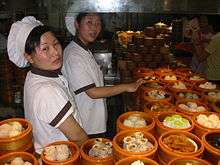 | |||||||||||||||||
| Traditional Chinese | 點心 | ||||||||||||||||
|---|---|---|---|---|---|---|---|---|---|---|---|---|---|---|---|---|---|
| Simplified Chinese | 点心 | ||||||||||||||||
| Hanyu Pinyin | diǎn xin | ||||||||||||||||
| Cantonese Jyutping | dim2 sam1 | ||||||||||||||||
| |||||||||||||||||
Dim sum /ˈdimˈsʌm/ (simplified Chinese: 点心; traditional Chinese: 點心; pinyin: Diǎnxīn; Sidney Lau: dim2sam1) is a style of Chinese cuisine (particularly Cantonese but also other varieties) prepared as small bite-sized portions of food served in small steamer baskets or on small plates. Dim sum dishes are usually served with tea, together formed a full tea brunch. Dim sum traditionally are served as fully cooked, ready-to-serve dishes. In the Cantonese teahouse, carts with dim sum will be served around the restaurant for diners to order without leaving their seats.
History
Dim sum is usually linked with the older tradition from yum cha (drinking tea), which has its roots in travelers on the ancient Silk Road needing a place to rest. Thus, teahouses were established along the roadside. An imperial physician in the third century wrote that combining tea with food would lead to excessive weight gain . People later discovered that tea can aid in digestion, so teahouse owners began adding various snacks.[1]
The unique culinary art dim sum originated with the Cantonese in southern China, who over the centuries transformed yum cha from a relaxing respite to a loud and happy dining experience. In Hong Kong, and in most cities and towns in Guangdong province, many restaurants start serving dim sum as early as five in the morning. It is a tradition for the elderly to gather to eat dim sum after morning exercises. For many in southern China, yum cha is treated as a weekend family day. More traditional dim sum restaurants typically serve dim sum until mid-afternoon. However, in modern society, it has become commonplace for restaurants to serve dim sum at dinner time; various dim sum items are even sold as take-out for students and office workers on the go.
Cuisine
A traditional dim sum brunch includes various types of steamed buns such as cha siu bao (a steamed bun filled with barbecue pork), dumplings and rice noodle rolls (cheong fun), which contain a range of ingredients, including beef, chicken, pork, prawns, and vegetarian options. Many dim sum restaurants also offer plates of steamed green vegetables, roasted meats, congee and other soups. Dessert dim sum is also available and many places offer the customary egg tart. Dim sum is usually eaten as breakfast.
Dim sum can be cooked by steaming and frying, among other methods. The serving sizes are usually small and normally served as three or four pieces in one dish. It is customary to order family style, sharing dishes among all members of the dining party. Because of the small portions, people can try a wide variety of food.
Dishes
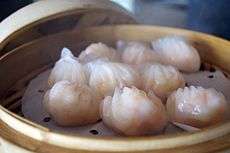
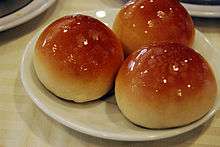

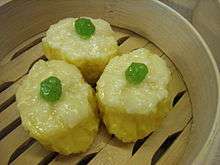
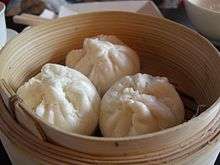
Dim sum brunch restaurants have a wide variety of dishes, usually several dozen. Among the standard fare of dim sum are the following:
Popular
- Gao zi, or Dumpling (Chinese: 餃; 餃子; Cantonese Yale: gaau2; gaau2 ji2): Jiao zi is a standard in most teahouses. They are made of ingredients wrapped in a translucent rice flour or wheat starch skin, and are different from jiaozi found in other parts of China. Though common, steamed rice-flour skins are quite difficult to make. Thus, it is a good demonstration of the chef's artistry to make these translucent dumplings. There are also dumplings with vegetarian ingredients, such as tofu and pickled cabbage.
- Har gow (shrimp dumplings)[2] (蝦餃 haa1 gaau2): A delicate steamed dumpling with whole or chopped-up shrimp filling and thin wheat starch skin.[3]
- Chinese sticky rice (Chinese: 糯米飯; pinyin: nuòmǐ fàn; Cantonese Yale: no6 mai5 faan6): A Chinese fried rice variety which is sticky
- Teochew-style dumplings (潮州粉果 ciu4 zau1 fan2 gwo2): A dumpling said to have originated from the Chaozhou (Teochew) prefecture of eastern Guangdong province, it contains peanuts, garlic, chives, pork, dried shrimp, and Chinese mushrooms in a thick dumpling wrapper made from glutinous rice flour or Tang flour. It is usually served with a small dish of chili oil.
- Guotie (pot stickers)[4] (鍋貼, wo1 tip3): Northern Chinese style of dumpling (steamed and then pan-fried jiaozi), usually with meat and cabbage filling.[5] Note that although potstickers are sometimes served in dim sum restaurants, they are not considered traditional Cantonese dim sum.
- Shaomai (燒賣 siu1 maai6): Small steamed dumplings with either pork, prawns or both inside a thin wheat flour wrapper. Usually topped off with crab roe and shiitake mushroom.[3]
- Haam Seoi Gaau (鹹水餃 haam4 seoi2 gaau2, salt-water (i.e. savoury) stuffed-dumpling, alternatively 鹹水角 haam4 seoi2 gok3): deep fried oval-shaped dumpling made with rice-flour and filled with pork and chopped vegetables. The rice-flour surrounding is sweet and sticky, while the inside is slightly salty and savoury.
- Dumpling soup (灌湯餃 gun3 tong1 gaau2): soup with one or two big dumplings.
- Baozi (包 baau1 or 包子 baau1 zi2): Baked or steamed, these fluffy buns made from wheat flour are filled with food items ranging from meat to vegetables to sweet bean pastes.
- Char siu bao(叉燒包 caa1 siu1 baau1): the most popular bun with a Cantonese barbecued pork filling. It can be either steamed to be fluffy and white or baked with a light sugar glaze to produce a smooth golden-brown crust. Traditionally, it's using the bun-like making method, but nowadays it's using the bread-like making method and using the name Caan-Baau (meal-bread).
- Bor Lor Baau (菠蘿包 bo1 lo4 baau1): literally means Pine apple bread. It's a pine-apple skin-like bread, usually taste sweet.
- Xiao long bao (上海小籠包 seong6 hoi2 siu2 lung4 baau1): These dumplings are filled with meat or seafood and are famous for their flavor and rich broth inside. These dumplings are originally Shanghainese so they are not considered traditional Cantonese dim sum. They are typically sold with pork or crab.
- Mantou (饅頭 maan4 tau4): plain steamed bun like char siu boa without filling.
- Phoenix claws (鳳爪 fung6 zaau2): These are chicken feet, deep fried, boiled, marinated in a black bean sauce and then steamed. This results in a texture that is light and fluffy (due to the frying), while moist and tender. Fung zau are typically dark red in color. One may also sometimes find plain steamed chicken feet served with a vinegar dipping sauce. This version is known as "White Cloud Phoenix Claws" (白雲鳳爪 baak6 wan4 fung6 jaau2).
- Steamed meatball (牛肉球 ngau4 juk6 kau4): Finely ground beef is shaped into balls and then steamed with preserved orange peel and served on top of a thin bean-curd skin.
- Spare ribs: In the west, it is mostly known as spare ribs collectively. In the east, it is Char siu when roasted red, or (排骨 paai4 gwat1) when roasted black. It is typically steamed with douchi or fermented black beans and sometimes sliced chilli.
- Lotus leaf rice (糯米雞 lo6 mai5 gai1): Glutinous rice is wrapped in a lotus leaf into a triangular or rectangular shape. It contains egg yolk, dried scallop, mushroom, crispy water chestnut, and meat (usually pork and chicken). These ingredients are steamed with the rice and although the leaf is not eaten, its flavour is infused during the steaming. Lo mai gai is a kind of rice dumpling. A similar but lighter variant is known as "Pearl Chicken" (珍珠雞 zan1 zyu1 gai1).
- Congee (粥 zuk1): Thick, sticky rice porridge served with different savory items. The porridge one will see most often is "Preserved Egg and Pork Porridge" (皮蛋瘦肉粥 "pei4 daan6 sau3 juk6 zuk1")
- Sou (酥 sou1): A type of flaky pastry. Char siu is one of the most common ingredient used in dim sum style sou. Another common pastry seen in restaurants are called "Salty Pastry" (鹹水角 "haam4 seoi2 gok3") which is made with flour and seasoned pork.
- Taro dumpling (芋角 wu6 gok3): This is made with mashed taro, stuffed with diced shiitake mushrooms, shrimp and pork, deep-fried in crispy batter.
- Crispy fried squid (魷魚鬚 jau4 jyu4 sou1): Similar to fried calamari, the battered squid is deep-fried. A variation of this dish may be prepared with a salt and pepper mix. In some dim sum restaurants, octopus is used instead of squid.
- Rolls (捲 gyun2)
- Spring roll (春捲 ceon1 gyun2): a roll consisting of various types of vegetables – such as sliced carrot, cabbage, mushroom and wood ear fungus – and sometimes meat are rolled inside a thin flour skin and deep fried.
- Rice noodle rolls or coeng fan (腸粉 coeng4 fan2): These are wide rice noodles that are steamed and then rolled. They are often filled with different types of meats or vegetables inside but can be served without any filling. Rice noodle rolls are fried after they are steamed and then sprinkled with sesame seeds. Popular fillings include beef, dough fritter, shrimp, and barbecued pork. Often topped with a sweetened soy sauce.
- Tofu skin roll (腐皮捲 fu6 pei4 gyun2): a roll made of Tofu skin
- Puddings (糕 gou1)
- Turnip pudding (蘿蔔糕 lo4 baak6 gou1): puddings are made from mashed daikon mixed with bits of dried shrimp and pork sausage that are steamed and then cut into slices and pan-fried.
- Taro pudding (芋頭糕 wu6 tao4 gou1): puddings made of taro.
- Water chestnut pudding (馬蹄糕 maa5 tai2 gou1): puddings made of crispy water chestnut. It is mostly see-through and clear. Some restaurants also serve a variation of water chestnut cake made with bamboo juice.
- Coconut milk pudding(椰汁糕 je4 zap1 gou1): puddings made from coconut milk and coconut water. These are light, and spongy but creamy puddings made with coconut milk on the bottom, with a thinner clear, jelly layer made with coconut water on top.
Sweets

- Chien chang go (千層糕 cin1 cang4 gou1): "Thousand-layer cake", a dim sum dessert made up of many layers of sweet egg dough.
- Egg tart[6] (蛋撻 daan6 taat1): composed of a base made from either a flaky puff pastry type dough or a type of non-flaky cookie dough with an egg custard filling, which is then baked. Some high class restaurants put bird's nest on top of the custard. In other places egg tarts can be made of a crust and a filling of egg whites and some where it is a crust with egg yolks. Egg tarts now come in a variety of different flavors, taro, coffee, and strawberry for example. 葡撻 (po4 taat1) is a Portuguese styled egg custard, common in Hong Kong, with origins in Macau, and has a layer of burnt sugar on the surface.
- Jin deui or Matuan (煎堆 zin1 deoi1 or 麻糰): Especially popular at Chinese New Year, a chewy dough filled with red bean paste, rolled in sesame seeds, and deep fried.
- Dou fu fa (豆腐花 dau6 fu6 faa1): A dessert consisting of silky tofu served with a sweet ginger or jasmine flavored syrup.
- Mango pudding[7] (芒果布甸 mong1 gwo2 bou3 din1): A sweet, rich mango-flavoured pudding usually with large chunks of fresh mango; often served with a topping of evaporated milk.
- Sweet cream buns (奶皇包 naai5 wong4 baau1): Steamed buns with milk custard filling.
- Malay Steamed Sponge Cake (馬拉糕 ma5 laai1 gou1): A very soft steamed sponge cake flavoured with molasses.
- Longan Tofu: almond-flavoured tofu served with longans, usually cold.
- Rice sugar cake:白糖糕
Tea service

The drinking of tea is as important to dim sum as the food. The type of tea to serve on the table is typically one of the first things the server asks dining customers. Several types of tea are served during dim sum :
Chrysanthemum tea – Chrysanthemum tea does not actually contain any tea leaves. Instead it is a flower-based tisane made from chrysanthemum flowers of the species Chrysanthemum morifolium or Chrysanthemum indicum, which are most popular in East Asia. To prepare the tea, chrysanthemum flowers (usually dried) are steeped in hot water (usually 90 to 95 °C (194 to 203 °F) after cooling from a boil) in either a teapot, cup, or glass. However, Chrysanthemum flowers are often paired with Pu-erh tea, and this is often referred to as guk pou or guk bou (菊普; pinyin: jú pǔ).
Green tea – Freshly picked leaves only go through heating and drying processes, but do not undergo oxidation. This enables the leaves to keep their original green color and retain most natural substances like polyphenols and chlorophyll contained within the leaves. This kind of tea is produced all over China and is the most popular category of tea. Representative varieties include Dragon Well (Long Jing) and Biluochun from Zhejiang and Jiangsu Provinces respectively.
Oolong tea – The tea leaves are partially oxidized, imparting to them the characteristics of both green and black teas. Its taste is more similar to green tea than black tea, but has a less "grassy" flavor than green tea. The three major oolong-tea producing areas are on the southeast coast of China e.g. Fujian, Guangdong and Taiwan. Tie Guan Yin, also referred to as "Tit Kwun Yum", "Ti Kwan Yin", "Iron Buddha" or "Iron Goddess Oolong", is one of the most popular choice of tea when serving with Dim Sum. Tie Guan Yin is originally cultivated in Fujian province. It is a premium variety of Oolong tea with delightful fragrance.
Bo-lei tea (Cantonese) or Pu-erh tea (Mandarin) – The tea has undergone years of fermentation, giving them a unique earthy flavor. This variety of tea is usually compressed into different shapes like bricks, discs and bowls.
Scented teas – There can be various mixtures of flowers with green tea, black tea or oolong tea. Flowers used include jasmine, gardenia, magnolia, grapefruit flower, sweet-scented osmanthus and rose. There are strict rules about the proportion of flowers to tea. Jasmine tea is the most popular type of scented tea, and is often the most popular type of tea served at yum cha establishments.
The above teas are produced in most of China. Chinese tea bushes (Camellia sinensis) are cultivated in the mountain areas of tropical and subtropical regions or wherever there is a proper climate, sufficient humidity, adequate sunshine and fertile soil. Chinese tea is classified in many ways, e.g., quality, method of preparation or place of production. The main processing methods include oxidation, fermentation, heating, drying and addition of other ingredients like flowers, herbs or fruits. These help to develop the special flavor of the raw tea leaves.
Restaurants and pricing
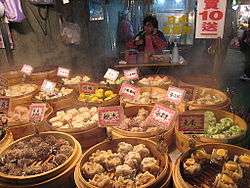
One aspect unique to dim sum is its method of serving in specialized dim sum brunch restaurants or teahouses.[8] Here, dishes are pushed around the restaurant in steam-heated carts, with servers offering the dishes to customers.[8][9] Pricing of dishes at these types of restaurants may vary, but traditionally the dishes are classified as "small", "medium", "large", "extra-large", or "special". For example, a basket of dumplings may be considered a small dish, while a bowl of congee or plate of lo mai gai may be considered a large dish. Dishes are then priced accordingly by size, with orders typically recorded with a rubber stamp onto a bill card that remains on the table. Servers in some restaurants use distinctive stamps, so that sales statistics for each server can be recorded. Menu items not typically considered dim sum fare, such as a plate of chow mein, are often available; they are typically branded as "kitchen" dishes on menus and are individually priced.
As a means of attracting customers at less busy times, many restaurants have promotional periods on certain days, usually in the early morning or late afternoon. This typically involves charging a fixed price for certain dishes. Typically, the "small", "medium" and "large" items are all charged at the usual price for "small" items; the rule would not apply to "extra large", "special", or "kitchen" dishes. In some places the "tea fee" may also be waived, or a discount be placed on the entire order. Where such periods exist the bill card would have a designated section that allows the items that were ordered during the period and to be easily recognized and charged appropriately.
Another way of pricing the food consumed is to use the number and color of the dishes left on the patron's table as a guide, similar to the method used in some Japanese conveyor belt sushi restaurants. Some newer restaurants offer a "conveyor belt dim sum" format, similar to the conveyor belt sushi eating places.
Other Chinese restaurants may not offer dim sum on moving platforms, and instead take orders, generally on a pre-printed sheet of paper, and serve à la carte, in a manner similar to a Spanish tapas restaurant. Prices of each dim sum dish may then vary depending on the actual dish ordered. This procedure may be used at less busier times in specialized restaurants, as it saves time and resources by chefs not having to anticipate which dishes would be ordered and prepare them in advance; though for the customer, it may take longer for the dishes to be delivered after ordering.
Etiquette

There are common tea-drinking and eating practices or etiquette that Chinese people commonly recognize and use. These are practiced not only during dim sum meals but during other types of Chinese meals as well.
It is customary to pour tea for others before filling one's own cup during a meal. When pouring tea for people on one's left side, the right hand should be used to hold the teapot and vice versa. A common custom among the Cantonese is to thank the person pouring the tea by tapping the bent index finger (if you are single), or by tapping both the index and middle finger (if you are married), which symbolizes the gesture of bowing.[10][11]
This custom is said to be analogous to the ritual of bowing to someone in appreciation. The origin of this gesture is described anecdotally: The Qianlong Emperor went to yum cha with his friends, outside the palace; not wanting to attract attention to himself, the Emperor was disguised. While at yum cha, the Emperor poured his companion some tea, which was a great honor. The companion, not wanting to give away the Emperor's identity in public by bowing, instead tapped his index and middle finger on the table as a sign of appreciation.
Given the number of times tea is poured in a meal, the tapping is a timesaver in loud restaurants or lively company, as an individual being served might be speaking to someone else or have food in their mouth. If a diner does not wish a refill being offered at that time, the fingers are used to "wave off" or politely decline more tea. This does not preclude taking more fresh hot tea at a later time during the meal.
Leaving the lid balanced on the side of the tea pot is a common way of attracting a server's attention, and indicates a silent request that the tea pot be refilled.
Fast food
Instant dim sum as a fast food has come onto the market in Hong Kong,[12] Mainland China,[13] Taiwan, Indonesia, Singapore, and Malaysia. People can enjoy snacks after a three-minute defrosting or reheating of the instant dim sum in a microwave oven.[12]
In many cities, "street dim sum" is sold from mobile carts and usually consists of dumplings or meatballs steamed in a large container and served on a bamboo skewer. The customer can dip the whole skewer into a sauce bowl and then eat while standing or walking.
Dim sum can be purchased from major grocery stores in most countries with a Chinese population. These dim sum can be easily cooked by steaming or microwaving. Major grocery stores in Hong Kong, Philippines, Singapore, Taiwan, Mainland China, Indonesia, Malaysia, Brunei, Thailand, Australia, United States, and Canada have a variety of frozen or fresh dim sum stocked at the shelves. These include dumplings, siu maai, bao, cheong fun, lo bak go and steamed spare ribs.
In Singapore, as well as other countries, dim sum can be purchased from convenience stores, coffee shops and other eateries. There is halal certified dim sum available (with chicken taking the place of pork) which is very popular in Malaysia, Indonesia and Brunei.
See also
- Cantonese cuisine
- Chinese pastry
- Cuisine of Hong Kong
- Dim sim, Australian dumpling inspired by Dim Sum, with origins in local Cantonese restaurants.
- List of brunch foods
- List of dumplings
- Meze
- Tapas
- Thali
References
- ↑ Parkinson, Rhonda. "Delicious Dim Sum – Chinese Brunch". About.com-Chinese Food. About.com. Retrieved 21 March 2013.
- ↑ Phillips, C. (2016). The Dim Sum Field Guide: A Taxonomy of Dumplings, Buns, Meats, Sweets, and Other Specialties of the Chinese Teahouse. Potter/TenSpeed/Harmony. p. 35. ISBN 978-1-60774-957-8. Retrieved November 5, 2016.
- 1 2 Albala, Ken (2011). Food Cultures of the World Encyclopedia. 3. ABC-CLIO. p. 89. ISBN 978-0-313-37626-9 – via Google Books.
- ↑ 1001 Foods To Die For. Andrews McMeel Publishing. 2007. p. 32. ISBN 978-0-7407-7043-2. Retrieved November 5, 2016.
- ↑ Phillips, Carolyn (2016). The Dim Sum Field Guide: A Taxonomy of Dumplings, Buns, Meats, Sweets, and Other Specialties of the Chinese Teahouse. Potter/TenSpeed/Harmony. p. 17. ISBN 1607749572 – via Google Books.
- ↑ Kho, K.L.; Horton, J. (2015). Phoenix Claws and Jade Trees: Essential Techniques of Authentic Chinese Cooking. Potter/TenSpeed/Harmony. p. 17. ISBN 978-0-385-34468-5. Retrieved November 5, 2016.
- ↑ Tate, N. (2011). Feeding the Dragon: A Culinary Travelogue Through China with Recipes. Andrews McMeel Publishing. p. 106. ISBN 978-1-4494-0111-5. Retrieved November 5, 2016.
- 1 2 Phillips, C. (2016). The Dim Sum Field Guide: A Taxonomy of Dumplings, Buns, Meats, Sweets, and Other Specialties of the Chinese Teahouse. Ten Speed Press. pp. 5–6. ISBN 978-1-60774-956-1. Retrieved November 5, 2016.
- ↑ Guides, R. (2010). The Rough Guide to Southeast Asia On A Budget. Rough Guides. p. 145. ISBN 978-1-4053-8686-9. Retrieved November 5, 2016.
- ↑ "Tea food". Taste of tea.Scent of leaves. Taste of tea.Scent of leaves. Retrieved 21 March 2013.
- ↑ AllabouttheChinese. "The Chinese Person's Guide to Dim Sum Etiquette: Tapping to Say Thanks!". All about the Chinese. All about the Chinese. Retrieved 21 March 2013.
- 1 2 Wu, D.Y.H.; Tan, C.B. (2001). Changing Chinese Foodways in Asia. Academic monograph on Chinese food culture. Chinese University Press. p. 56. ISBN 978-962-201-914-0. Retrieved November 5, 2016.
- ↑ Ball, S.; Horner, S.; Nield, K. (2009). Contemporary Hospitality and Tourism Management Issues in China and India. Taylor & Francis. p. 91. ISBN 978-1-136-41459-6. Retrieved November 5, 2016.
External links
| Wikimedia Commons has media related to Dim sum. |
